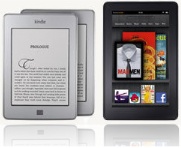Actually, a more accurate title would be, "Why I Had My Son Root My Kindle Fire." He had some spare time this weekend so I asked him to do the job for me. I simply emailed him this link, handed him my Fire and told him not to worry about the results. After all, I've hardly used my Fire since it arrived. I do all my book reading on my new Kindle Touch (highly recommended) and intended for the Fire to replace my iPad. But it hasn't.
My favorite iPad apps are Zite and Flipboard. Neither of them are available on Android. More importantly, I kept running into interesting apps that are available in the Android Market but not Amazon's appstore.
The rooted device looks and acts a lot like it did before. One key difference is that I can now go to the Android Market and download whatever I want. Here are a few I installed immediately:
The real Twitter app -- It's totally ridiculous that Amazon doesn't offer this one. Prior to this my Fire twittering took place in the browser. Awful idea.
The Dolphin browser -- Don't get me started about the Fire's supposedly super-fast Silk browser. I've done side-by-side test with my iPad, Galaxy S II phone and Mac PowerBook Pro. The results show the Fire browser comes in last place pretty much every time I load a page, reload a page, etc. This is one of the most disappointing aspects of the Fire. I originally planned for it to be a fast, small browsing device. Now that I have Dolphin installed it's at least as fast as my iPad. Amazon should publicly apologize for the misleading promises they made about Silk.
The Everpaper app -- I'm a big fan of Instapaper. The Fire's smaller size should make it a better alternative for this sort of short-form reading than the iPad. Sure Amazon offers InstaFetch but it's not as good as Everpaper. I'd argue that Everpaper is a better app than Instapaper's own one on iOS. Isn't Amazon supposed to curating a list of the best apps for their own app store? If so, why are they leaving this terrific one out?
News360 -- This one is an excellent news aggregator that's well designed for a tablet user interface. Again, for some silly reason Amazon has decided it's not worthy of their own app store.I could go on and on but I won't. I'm sure I'll discover more each day and I'll be sure to report the best ones on Kindleville. I should also mention that every Android Market app doesn't come with a simple installation process on a rooted Kindle. In fact, I've come across a number of apps that simply don't show up in the Market search results when I look for them on my Fire. The solution there is to back up the .apk file on my Android phone and email them to myself. I then open the .apk on my Fire and most install just fine. Btw, if you need to do the same you'll want to install the free ASTRO File Manager app on your phone. It's a great little tool.
Then there are the apps that, for one reason or another, simply won't install on a rooted Kindle Fire. The biggest disappointment so far is Google Currents. I'm getting tired waiting for Zite and/or FlipBoard to appear on the Android platform and Currents is a nice app on my iPad. I've tried installing it a couple of times on my rooted Kindle and it always ends with a failure message. Bummer.
I'm also pretty sure the next time Amazon pushes out a Fire OS update it will unroot the device. My son tells me he can re-root it in a matter of minutes though now that he's done it once. That's good news because there's no way I'm going back to the walled ghetto Amazon has created with the standard Fire setup.




